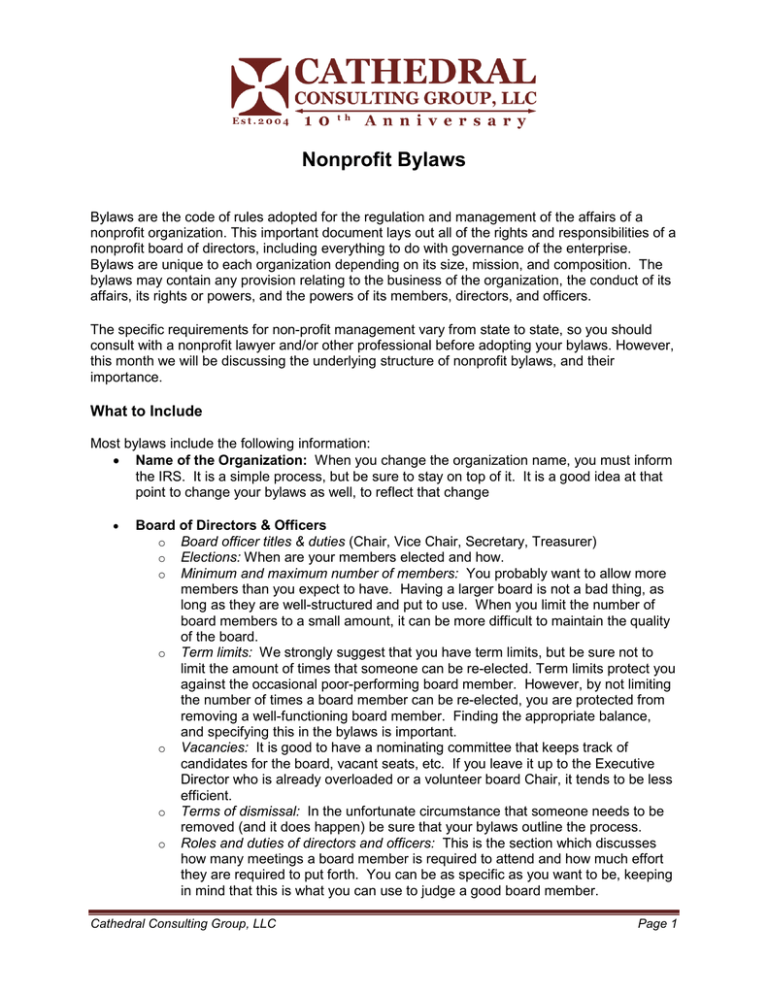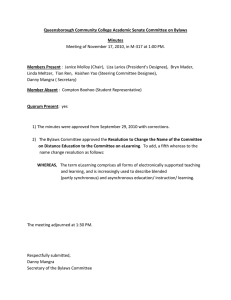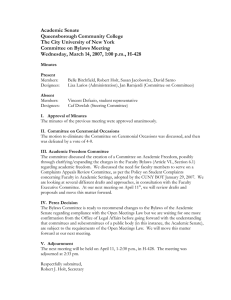Nonprofit Bylaws
advertisement

Nonprofit Bylaws Bylaws are the code of rules adopted for the regulation and management of the affairs of a nonprofit organization. This important document lays out all of the rights and responsibilities of a nonprofit board of directors, including everything to do with governance of the enterprise. Bylaws are unique to each organization depending on its size, mission, and composition. The bylaws may contain any provision relating to the business of the organization, the conduct of its affairs, its rights or powers, and the powers of its members, directors, and officers. The specific requirements for non-profit management vary from state to state, so you should consult with a nonprofit lawyer and/or other professional before adopting your bylaws. However, this month we will be discussing the underlying structure of nonprofit bylaws, and their importance. What to Include Most bylaws include the following information: • Name of the Organization: When you change the organization name, you must inform the IRS. It is a simple process, but be sure to stay on top of it. It is a good idea at that point to change your bylaws as well, to reflect that change • Board of Directors & Officers o Board officer titles & duties (Chair, Vice Chair, Secretary, Treasurer) o Elections: When are your members elected and how. o Minimum and maximum number of members: You probably want to allow more members than you expect to have. Having a larger board is not a bad thing, as long as they are well-structured and put to use. When you limit the number of board members to a small amount, it can be more difficult to maintain the quality of the board. o Term limits: We strongly suggest that you have term limits, but be sure not to limit the amount of times that someone can be re-elected. Term limits protect you against the occasional poor-performing board member. However, by not limiting the number of times a board member can be re-elected, you are protected from removing a well-functioning board member. Finding the appropriate balance, and specifying this in the bylaws is important. o Vacancies: It is good to have a nominating committee that keeps track of candidates for the board, vacant seats, etc. If you leave it up to the Executive Director who is already overloaded or a volunteer board Chair, it tends to be less efficient. o Terms of dismissal: In the unfortunate circumstance that someone needs to be removed (and it does happen) be sure that your bylaws outline the process. o Roles and duties of directors and officers: This is the section which discusses how many meetings a board member is required to attend and how much effort they are required to put forth. You can be as specific as you want to be, keeping in mind that this is what you can use to judge a good board member. Cathedral Consulting Group, LLC Page 1 • • • • • • • Committees: We recommend only having a few standing committees. Some of the common ones are Executive Committee, Finance Committee, Nominating Committee, Program and Fundraising. Leave open the possibility of creating ad hoc committees at the Chairman’s discretion. Meetings o Dates and times of regular meetings. We recommend 3 to 5 meetings a year for a well functioning board. Keep in mind this doesn’t include committee meetings. You may also want to specify whether people can participate by phone. o Date of Annual Meeting: Most bylaws specify this. However, if you went to your bylaws right now and checked this date, there is a good chance you will find that you are not having your annual meeting on the dates listed in the bylaws. The annual meeting is an important one, in which you should be electing officers, presenting an annual report and setting the course for the year. o Special Meeting requirements: What process will you use to call special meetings? o Agendas: It is not a bad idea to create a standard agenda for board meetings and you might want to include it in your bylaws. Items to include on an agenda include: Review & Approve last meetings minutes, Report from the Executive Director, Report from Chairman and a Report from each standing and ad-hoc committee. o Minutes: You should specify who is responsible for the minutes in the bylaws. It is usually listed as a duty of the Secretary. Voting o Majority and supermajority definitions: Be clear on what it takes to pass a vote. Some people use supermajority for particular types of decisions, and use majority for basic decisions. For example, a major capital purchase or personnel decision may require a supermajority. This should be clearly addressed in your bylaws. o Quorum requirements: This is the number of board members necessary in attendance in order to hold a meeting and/or take a vote. o Decision making structure: Most groups use a simplified version of Roberts Rules. Our paper, “How to Run a Better Board Meeting” outlines a simplified Robert’s Rules procedures. Some faith-based groups prefer to use discernment or other “non-voting” procedures. In this case, the decision making process needs to be especially clear. Conflict of Interest policy o It is important that your organization has a policy in place, along with provisions for declaration of conflicts and recusal when necessary. The Form 990 informational tax return asks whether your organization has a conflict of interest policy and having such a policy has become the standard governance operating procedure for well run organizations. Fiscal Policies o Fiscal year of the board o Particular policies and procedures related to financial management Amendments. As your organization grows in size, it is recommended that the bylaws be reviewed and, if necessary, updated to accommodate institutional modifications. The bylaws should therefore provide the procedures for amending the document. Other essential corporate governance matters Cathedral Consulting Group, LLC Page 2 Use and Changes The bylaws are supposed to guide the governance of the organization. And since most organizations change their policies and procedures – either organically or by design, the bylaws need to be a living document. Organizations that rarely review their bylaws often end up with outdated bylaws that no longer reflect the organization's mission, needs, or direction. The classic progression of how this works is something like this: • • • • Every non-profit has bylaws. They must to incorporate, but they are usually done by a lawyer from a boilerplate, submitted to the IRS with the 501c3 application and never looked at again. Over time changes take place in the way the organization operates and the board functions. Sometimes, these changes are not in agreement with the bylaws, but the bylaws are not always amended to reflect the current way of doing things. Somewhere down the road, a dispute arises on the board, and someone says, “Let’s look at the bylaws.” They are dusted off, passed around, and the realization is stated aloud, “We’re not functioning in accordance with our bylaws.” An ad hoc bylaws committee is formed and scrambles to update the bylaws, usually resulting in a major overhaul. This should not be the way that bylaws are updated. As mentioned above, bylaws need to be a living document, referred to often and adjusted to reflect the changing nature of the organization. When substantial alterations are made to your bylaws, it is recommended that you contact an attorney to sign off on the changes, and then report the changes to the IRS. Minor changes can just be reported on next year’s Form 990. Storage Bylaws should be filed electronically and in hard-copy in a safe, easy-accessible place. When any changes are made to the master template, the by-laws should be sent around to anyone who may have a copy of them, along with a note that requests any old copies are disposed of. You don’t want to find yourself in a situation where each board member has a different version of the bylaws. Bylaws are not public documents, but making them readily available will increase your accountability and encourage your board to pay closer attention to them. What’s The Big Deal? The IRS expects you to have up to date bylaws. If the organization gets in major legal trouble, the content of your bylaws can become material. But this situation is rare. The real issue is good governance. In the life cycle of every organization there will be times when disputes need to be resolved, or questions answered. Bylaws provide an objective standard that you can refer to in order to settle disputes properly. Internally, bylaws help keep the board on track to guiding the organization. Well thought-out bylaws will make an organization more efficient. The board could appoint a governance committee that meets once a year prior to annual meeting to make recommendations to the board as to whether any changes need to be made to the bylaws and related policies and procedures. Conclusion Focus on keeping your bylaws a living document. Use it in board meetings, abide by its policies to make decisions and make amendments to it when necessary. Adhering to your bylaws and Cathedral Consulting Group, LLC Page 3 referring to them when in question will help your organization stand out as a professional nonprofit organization, setting itself up for growth. Additional Information 1. Nonprofit Terms: http://www.nonprofithub.com/dictionary.htm 2. How Nonprofits Differ From For-profits – and How They Are the Same: http://www.managementhelp.org/misc/Nonprofits-ForProfits.pdf Peter Giersch is the COO and Managing Director of Cathedral Consulting Group, LLC and Melissa Mason is a former Associate in the Milwaukee office. Daniel R. Alcott is a Partner at The Dorf Law Firm in Westchester County, New York, where he heads up the firm’s Not-for-Profit Tax Exempt Organizations department. He can be contacted via email at dalcott@dorflaw.com For more information, please visit Cathedral Consulting Group LLC online at www.cathedralconsulting.com or contact us at info@cathedralconsulting.com. May e-Fundraising Tip Know your Audience! Many nonprofit organizations know a lot about their target audience offline – their individual donors, major donors and constituents for example. But what about the everincreasing online audience? Who is giving online – most importantly, who should your online fundraising efforts be targeted at? Here are a few quick facts from the latest donorCentrics Internet Giving Benchmark Analysis: • Online donors are significantly younger and have higher incomes than donors giving through traditional channels, such as direct mail. • 34% of online donors earned over $100,000 annually compared to a median of only 24% of offline donors in the same income range. • Donors in the Southwestern and Mountain States are much more likely to give online, whereas mid-Atlantic and upper Midwest states are much less likely to give online. • 73% of online donors are between the ages of 35 and 64 • 51.8% of online donors are new donors. Cathedral Consulting Group, LLC Page 4


